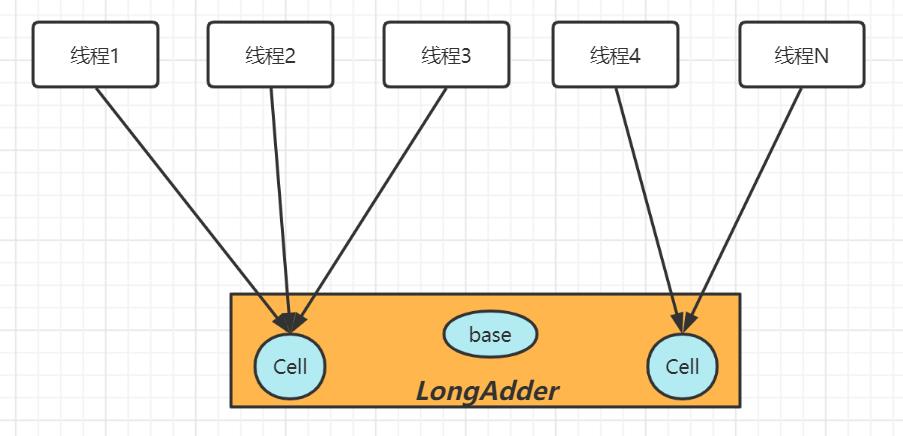Java Review - 并发编程_JDK 8新增的原子操作类LongAdder & LongAccumulator
Posted 小小工匠
tags:
篇首语:本文由小常识网(cha138.com)小编为大家整理,主要介绍了Java Review - 并发编程_JDK 8新增的原子操作类LongAdder & LongAccumulator相关的知识,希望对你有一定的参考价值。
文章目录

概述
Java Review - 并发编程_原子操作类原理剖析中提到了 AtomicLong通过CAS提供了非阻塞的原子性操作,相比使用阻塞算法的同步器来说它的性能已经很好了,但是JDK开发组并不满足于此。使用AtomicLong时,在高并发下大量线程会同时去竞争更新同一个原子变量,但是由于同时只有一个线程的CAS操作会成功,这就造成了大量线程竞争失败后,会通过无限循环不断进行自旋尝试CAS的操作,而这会白白浪费CPU资源。
因此JDK 8新增了一个原子性递增或者递减类LongAdder用来克服在高并发下使用AtomicLong的缺点。
既然AtomicLong的性能瓶颈是由于过多线程同时去竞争一个变量的更新而产生的,那么如果把一个变量分解为多个变量,让同样多的线程去竞争多个资源,是不是就解决了性能问题?是的,LongAdder就是这个思路。

下面通过图来理解两者设计的不同之处


-
使用LongAdder时,则是在内部维护多个Cell变量,每个Cell里面有一个初始值为0的long型变量,这样,在同等并发量的情况下,争夺单个变量更新操作的线程量会减少,这变相地减少了争夺共享资源的并发量。
-
另外,多个线程在争夺同一个Cell原子变量时如果失败了,它并不是在当前Cell变量上一直自旋CAS重试,而是尝试在其他Cell的变量上进行CAS尝试,这个改变增加了当前线程重试CAS成功的可能性。
-
最后,在获取LongAdder当前值时,是把所有Cell变量的value值累加后再加上base返回的。
LongAdder维护了一个延迟初始化的原子性更新数组(默认情况下Cell数组是null)和一个基值变量base。由于Cells占用的内存是相对比较大的,所以一开始并不创建它,而是在需要时创建,也就是惰性加载。
当一开始判断Cell数组是null并且并发线程较少时,所有的累加操作都是对base变量进行的。保持Cell数组的大小为2的N次方,在初始化时Cell数组中的Cell元素个数为2,数组里面的变量实体是Cell类型。Cell类型是AtomicLong的一个改进,用来减少缓存的争用,也就是解决伪共享问题。
对于大多数孤立的多个原子操作进行字节填充是浪费的,因为原子性操作都是无规律地分散在内存中的(也就是说多个原子性变量的内存地址是不连续的),多个原子变量被放入同一个缓存行的可能性很小。但是原子性数组元素的内存地址是连续的,所以数组内的多个元素能经常共享缓存行,因此这里使用@sun.misc.Contended注解对Cell类进行字节填充,这防止了数组中多个元素共享一个缓存行,在性能上是一个提升。

小Demo
import java.util.concurrent.atomic.LongAdder;
/**
* @author 小工匠
* @version 1.0
* @description: TODO
* @date 2021/11/30 22:52
* @mark: show me the code , change the world
*/
public class AtomicLongTest
//(10)创建Long型原子计数器
// private static AtomicLong atomicLong = new AtomicLong();
private static LongAdder longAdder = new LongAdder();
//(11)创建数据源
private static Integer[] arrayOne = new Integer[]0, 1, 2, 3, 0, 5, 6, 0, 56, 0;
private static Integer[] arrayTwo = new Integer[]10, 1, 2, 3, 0, 5, 6, 0, 56, 0;
public static void main(String[] args) throws InterruptedException
//(12)线程one统计数组arrayOne中0的个数
Thread threadOne = new Thread(() ->
int size = arrayOne.length;
for (int i = 0; i < size; ++i)
if (arrayOne[i].intValue() == 0)
longAdder.increment();
);
//(13)线程two统计数组arrayTwo中0的个数
Thread threadTwo = new Thread(() ->
int size = arrayTwo.length;
for (int i = 0; i < size; ++i)
if (arrayTwo[i].intValue() == 0)
longAdder.increment();
);
//(14)启动子线程
threadOne.start();
threadTwo.start();
//(15)等待线程执行完毕
threadOne.join();
threadTwo.join();
System.out.println("count 0:" + longAdder.sum());

源码分析
为了解决高并发下多线程对一个变量CAS争夺失败后进行自旋而造成的降低并发性能问题,LongAdder在内部维护多个Cell元素(一个动态的Cell数组)来分担对单个变量进行争夺的开销。
先来思考几个问题
(1)LongAdder的结构是怎样的?
(2)当前线程应该访问Cell数组里面的哪一个Cell元素?
(3)如何初始化Cell数组?
(4)Cell数组如何扩容?
(5)线程访问分配的Cell元素有冲突后如何处理?
(6)如何保证线程操作被分配的Cell元素的原子性?

LongAdder类继承自Striped64类,在Striped64内部维护着三个变量。
LongAdder的真实值其实是base的值与Cell数组里面所有Cell元素中的value值的累加,base是个基础值,默认为0。
cellsBusy用来实现自旋锁,状态值只有0和1,当创建Cell元素,扩容Cell数组或者初始化Cell数组时,使用CAS操作该变量来保证同时只有一个线程可以进行其中之一的操作。
/**
* Padded variant of AtomicLong supporting only raw accesses plus CAS.
*
* JVM intrinsics note: It would be possible to use a release-only
* form of CAS here, if it were provided.
*/
@sun.misc.Contended static final class Cell
volatile long value;
Cell(long x) value = x;
final boolean cas(long cmp, long val)
return UNSAFE.compareAndSwapLong(this, valueOffset, cmp, val);
// Unsafe mechanics
private static final sun.misc.Unsafe UNSAFE;
private static final long valueOffset;
static
try
UNSAFE = sun.misc.Unsafe.getUnsafe();
Class<?> ak = Cell.class;
valueOffset = UNSAFE.objectFieldOffset
(ak.getDeclaredField("value"));
catch (Exception e)
throw new Error(e);
-
Cell的构造很简单,其内部维护一个被声明为volatile的变量,这里声明为volatile是因为线程操作value变量时没有使用锁,为了保证变量的内存可见性这里将其声明为volatile的。
-
cas函数通过CAS操作,保证了当前线程更新时被分配的Cell元素中value值的原子性。
-
Cell类使用@sun.misc.Contended修饰是为了避免伪共享。
到这里我们回答了问题1和问题6。

重要的方法
long sum()
返回当前的值,内部操作是累加所有Cell内部的value值后再累加base。
/**
* Returns the current sum. The returned value is <em>NOT</em> an
* atomic snapshot; invocation in the absence of concurrent
* updates returns an accurate result, but concurrent updates that
* occur while the sum is being calculated might not be
* incorporated.
*
* @return the sum
*/
public long sum()
Cell[] as = cells; Cell a;
long sum = base;
if (as != null)
for (int i = 0; i < as.length; ++i)
if ((a = as[i]) != null)
sum += a.value;
return sum;
由于计算总和时没有对Cell数组进行加锁,所以在累加过程中可能有其他线程对Cell中的值进行了修改,也有可能对数组进行了扩容,所以sum返回的值并不是非常精确的,其返回值并不是一个调用sum方法时的原子快照值。
reset
重置操作
/**
* Resets variables maintaining the sum to zero. This method may
* be a useful alternative to creating a new adder, but is only
* effective if there are no concurrent updates. Because this
* method is intrinsically racy, it should only be used when it is
* known that no threads are concurrently updating.
*/
public void reset()
Cell[] as = cells; Cell a;
base = 0L;
if (as != null)
for (int i = 0; i < as.length; ++i)
if ((a = as[i]) != null)
a.value = 0L;
base置为0,如果Cell数组有元素,则元素值被重置为0
sumThenReset
sum的改造版本
/**
* Equivalent in effect to @link #sum followed by @link
* #reset. This method may apply for example during quiescent
* points between multithreaded computations. If there are
* updates concurrent with this method, the returned value is
* <em>not</em> guaranteed to be the final value occurring before
* the reset.
*
* @return the sum
*/
public long sumThenReset()
Cell[] as = cells; Cell a;
long sum = base;
base = 0L;
if (as != null)
for (int i = 0; i < as.length; ++i)
if ((a = as[i]) != null)
sum += a.value;
a.value = 0L;
return sum;
在使用sum累加对应的Cell值后,把当前Cell的值重置为0, base重置为0。这样,当多线程调用该方法时会有问题,比如考虑第一个调用线程清空Cell的值,则后一个线程调用时累加的都是0值。
longValue()
等价于sum
/**
* Equivalent to @link #sum.
*
* @return the sum
*/
public long longValue()
return sum();
add(long x)
/**
* Adds the given value.
*
* @param x the value to add
*/
public void add(long x)
Cell[] as; long b, v; int m; Cell a;
if ((as = cells) != null || !casBase(b = base, b + x)) // 1
boolean uncontended = true;
if (as == null || (m = as.length - 1) < 0 || // 2
(a = as[getProbe() & m]) == null || // 3
!(uncontended = a.cas(v = a.value, v + x))) // 4
longAccumulate(x, null, uncontended); // 5
/**
* CASes the base field.
*/
final boolean casBase(long cmp, long val)
return UNSAFE.compareAndSwapLong(this, BASE, cmp, val);
-
代码(1)首先看cells是否为null,如果为null则当前在基础变量base上进行累加,这时候就类似AtomicLong的操作。 如果cells不为null或者线程执行代码(1)的CAS操作失败了,则会去执行代码(2)。
-
代码(2)(3)决定当前线程应该访问cells数组里面的哪一个Cell元素,如果当前线程映射的元素存在则执行代码(4),使用CAS操作去更新分配的Cell元素的value值,如果当前线程映射的元素不存在或者存在但是CAS操作失败则执行代码(5)。
其实将代码(2)(3)(4)合起来看就是获取当前线程应该访问的cells数组的Cell元素,然后进行CAS更新操作,只是在获取期间如果有些条件不满足则会跳转到代码(5)执行。
另外当前线程应该访问cells数组的哪一个Cell元素是通过getProbe() & m进行计算的,其中m是当前cells数组元素个数-1,getProbe()则用于获取当前线程中变量threadLocalRandomProbe的值,这个值一开始为0,在代码(5)里面会对其进行初始化。并且当前线程通过分配的Cell元素的cas函数来保证对Cell元素value值更新的原子性,到这里我们回答了问题2和问题6。

longAccumulate(long x, LongBinaryOperator fn, boolean wasUncontended)
cells数组被初始化和扩容的地方
final void longAccumulate(long x, LongBinaryOperator fn,
boolean wasUncontended)
//(6) 初始化当前线程的变量threadLocalRandomProbe的值
int h;
if ((h = getProbe()) == 0)
ThreadLocalRandom.current(); //
h = getProbe();
wasUncontended = true;
boolean collide = false;
for (; ; )
Cell[] as; Cell a; int n; long v;
if ((as = cells) ! = null && (n = as.length) > 0) //(7)
if ((a = as[(n -1) & h]) == null) //(8)
if (cellsBusy == 0) // Try to attach new Cell
Cell r = new Cell(x); // Optimistically create
if (cellsBusy == 0 && casCellsBusy())
boolean created = false;
try // Recheck under lock
Cell[] rs; int m, j;
if ((rs = cells) ! = null &&
(m = rs.length) > 0 &&
rs[j = (m -1) & h] == null)
rs[j] = r;
created = true;
finally
cellsBusy = 0;
if (created)
break;
continue; // Slot is now non-empty
collide = false;
else if (! wasUncontended) // CAS already known to fail
wasUncontended = true;
//当前Cell存在,则执行CAS设置(9)
else if (a.cas(v = a.value, ((fn == null) ? v + x :
fn.applyAsLong(v, x))))
break;
//当前Cell数组元素个数大于CPU个数(10)
else if (n >= NCPU || cells ! = as)
collide = false; // At max size or stale
//是否有冲突(11)
else if (! collide)
collide = true;
//如果当前元素个数没有达到CPU个数并且有冲突则扩容(12)
else if (cellsBusy == 0 && casCellsBusy())
try
if (cells == as) // Expand table unless stale
//12.1
Cell[] rs = new Cell[n << 1];
for (int i = 0; i < n; ++i)
rs[i] = as[i];
cells = rs;
finally
//12.2
cellsBusy = 0;
//12.3
collide = false;
continue; // Retry with expanded table
//(13)为了能够找到一个空闲的Cell,重新计算hash值,xorshift算法生成随机数
h = advanceProbe(h);
//初始化Cell数组(14)
else if (cellsBusy == 0 && cells == as && casCellsBusy())
boolean init = false;
try
if (cells == as)
//14.1
Cell[] rs = new Cell[2];
//14.2
rs[h & 1] = new Cell(x);
cells = rs;
init = true;
finally
//14.3
cellsBusy = 0;
if (init)
break;
else if (casBase(v = base, ((fn == null) ? v + x :
fn.applyAsLong(v, x))))
break; // Fall back on using base
上面代码比较复杂,这里我们主要关注问题3、问题4和问题5。
当每个线程第一次执行到代码(6)时,会初始化当前线程变量threadLocalRandomProbe的值,上面也说了,这个变量在计算当前线程应该被分配到cells数组的哪一个Cell元素时会用到。
cells数组的初始化是在代码(14)中进行的,其中cellsBusy是一个标示,为0说明当前cells数组没有在被初始化或者扩容,也没有在新建Cell元素,为1则说明cells数组在被初始化或者扩容,或者当前在创建新的Cell元素、通过CAS操作来进行0或1状态的切换,这里使用casCellsBusy函数。假设当前线程通过CAS设置cellsBusy为1,则当前线程开始初始化操作,那么这时候其他线程就不能进行扩容了。
如代码(14.1)初始化cells数组元素个数为2,然后使用h&1计算当前线程应该访问celll数组的哪个位置,也就是使用当前线程的threadLocalRandomProbe变量值&(cells数组元素个数-1),然后标示cells数组已经被初始化,最后代码(14.3)重置了cellsBusy标记。
显然这里没有使用CAS操作,却是线程安全的,原因是cellsBusy是volatile类型的,这保证了变量的内存可见性,另外此时其他地方的代码没有机会修改cellsBusy的值。在这里初始化的cells数组里面的两个元素的值目前还是null。这里回答了问题3,知道了cells数组如何被初始化。
cells数组的扩容是在代码(12)中进行的,对cells扩容是有条件的,也就是代码(10)(11)的条件都不满足的时候。具体就是当前cells的元素个数小于当前机器CPU个数并且当前多个线程访问了cells中同一个元素,从而导致冲突使其中一个线程CAS失败时才会进行扩容操作。
这里为何要涉及CPU个数呢?只有当每个CPU都运行一个线程时才会使多线程的效果最佳,也就是当cells数组元素个数与CPU个数一致时,每个Cell都使用一个CPU进行处理,这时性能才是最佳的。
代码(12)中的扩容操作也是先通过CAS设置cellsBusy为1,然后才能进行扩容。假设CAS成功则执行代码(12.1)将容量扩充为之前的2倍,并复制Cell元素到扩容后数组。
另外,扩容后cells数组里面除了包含复制过来的元素外,还包含其他新元素,这些元素的值目前还是null。这里回答了问题4。
在代码(7)(8)中,当前线程调用add方法并根据当前线程的随机数threadLocalRandomProbe和cells元素个数计算要访问的Cell元素下标,然后如果发现对应下标元素的值为null,则新增一个Cell元素到cells数组,并且在将其添加到cells数组之前要竞争设置cellsBusy为1。
代码(13)对CAS失败的线程重新计算当前线程的随机值threadLocalRandomProbe,以减少下次访问cells元素时的冲突机会。这里回答了问题5。
